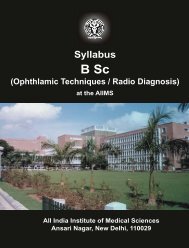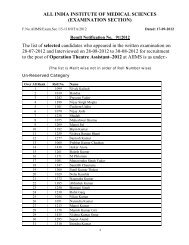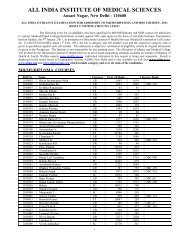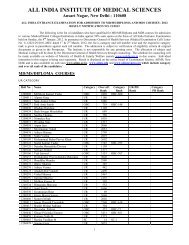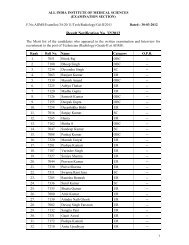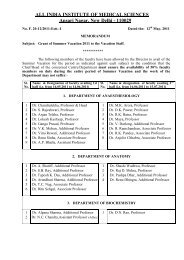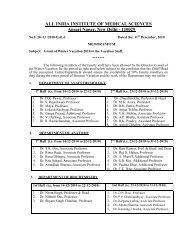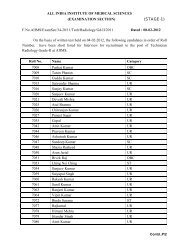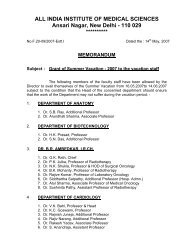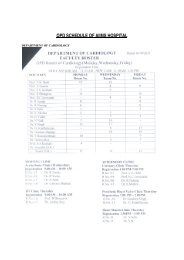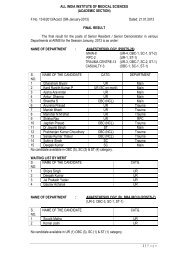Manual for long-term pharmacotherapy - All India Institute of Medical ...
Manual for long-term pharmacotherapy - All India Institute of Medical ...
Manual for long-term pharmacotherapy - All India Institute of Medical ...
Create successful ePaper yourself
Turn your PDF publications into a flip-book with our unique Google optimized e-Paper software.
Q 9. Can disulfiram be administered to a patient who is in a state <strong>of</strong> alcohol intoxication or without their<br />
full knowledge?<br />
Ans. Disulfiram should never be administered to a patient who is in a state <strong>of</strong> alcohol intoxication or without<br />
their full knowledge. Under both the circumstances, patient will develop disulfiram-ethanol reaction<br />
(DER) which can be life threatening.<br />
Q 10. What is disulfiram-ethanol reaction (DER)?<br />
Ans. Disulfiram acts by binding irreversibly to the enzyme acetaldehyde dehydrogenase, (ALDH) leading to<br />
inactivation <strong>of</strong> the enzyme. When alcohol is consumed subsequent to disulfiram intake, there is an<br />
accumulation <strong>of</strong> acetaldehyde due to inhibition <strong>of</strong> the enzyme that metabolises it. Elevated levels <strong>of</strong><br />
acetaldehyde are responsible <strong>for</strong> the unpleasant effects experienced. This is <strong>term</strong>ed as the Disulfiram-<br />
Ethanol Reaction (DER). High levels <strong>of</strong> acetaldehyde produce nausea, substantial vomiting,<br />
hyperventilation, chest pain, flushing, throbbing headache, light-headedness, palpitation, blurred<br />
vision and other unpleasant symptoms. In rare cases arrhythmias, acute heart failure, convulsion and<br />
death may occur. The patient's reaction will be proportional to the dosage <strong>of</strong> both disulfiram and alcohol,<br />
and will continue to occur as <strong>long</strong> as alcohol is being metabolized.<br />
Q 11. How should disulfiram-ethanol reaction (DER) be treated?<br />
Ans. The disulfiram-ethanol reaction is treated symptomatically. Patient will require monitoring <strong>of</strong> pulse and<br />
blood pressure. Vasopressors and antiarrythymic agents may have to be given in case hypotension or<br />
cardiac arrhythmias occur.<br />
Q 12. How does disulfiram help in maintaining abstinence or preventing relapse?<br />
Ans. The underlying principle <strong>for</strong> using disulfiram in treating alcoholism is that most alcoholics taking<br />
disulfiram will avoid drinking because they fear getting sick. Thus, disulfiram prevents impulsive<br />
drinking and allows the patient time to think about other ways to cope with acute cravings or stressful<br />
moments.<br />
Q 13. When to start disulfiram in a patient using alcohol?<br />
Ans. Disulfiram should be started after detoxification from alcohol is completed and the patient is free <strong>of</strong><br />
alcohol or alcohol containing beverages <strong>for</strong> at least 12 hours be<strong>for</strong>e the start <strong>of</strong> disulfiram.<br />
Q 14. At which time <strong>of</strong> the day, disulfiram should be used daily?<br />
Ans. The timing <strong>of</strong> the dose should be fixed, such that the patient takes the tablet at a particular time <strong>of</strong> the day.<br />
Some patients may experience sedation with morning use; in such cases the dose may be shifted to night<br />
time. It is always advisable to take the tablets in the morning following the breakfast under the<br />
supervision <strong>of</strong> a significant family member. This helps in two ways; Firstly, it takes away from the patient<br />
the thought <strong>of</strong> using alcohol <strong>for</strong> the whole day and secondly it helps in building the trust between the<br />
patient and the significant family member.<br />
Q 15. What should be done if a patient develops psychosis while on disulfiram?<br />
Ans. Psychotic reactions are uncommon with disulfiram. However, it is usually noted when a patient is on<br />
11




